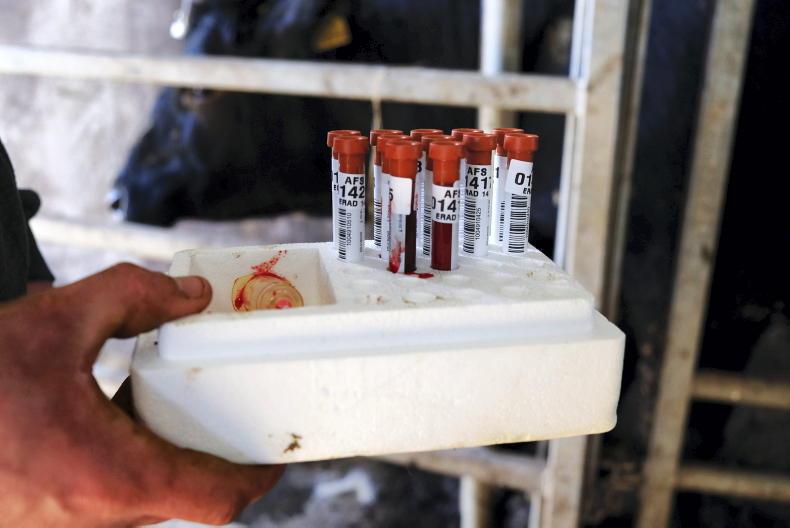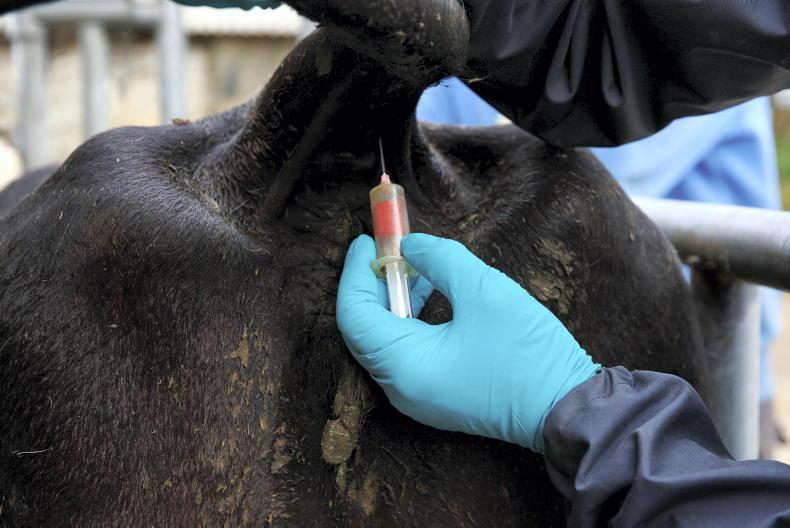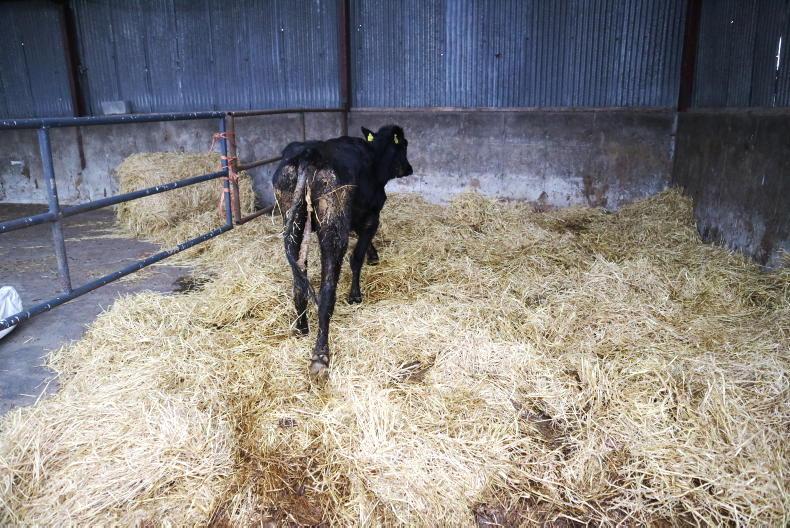Animal Health Ireland (AHI) launched the Irish Johne’s control programme in 2018. To date, 1,876 farmers are signed up to the programme, which represents a relatively small proportion of all dairy farmers in Ireland.
AHI estimates that 20% of Irish dairy herds have been exposed to the disease, although most Irish farmers probably haven’t seen the full effects of it.
The classic clinical symptom of Johne’s is a cow wasting away. It is caused by a bacteria which has been linked to Crohn’s disease in humans, although this link is not clear and is the subject of much debate.
Many people see the threat of Johne’s disease to be greater if it was identified to be zoonotic and the damage this could cause to the dairy industry, rather than just on the current animal health risks.
Having said that, AHI estimates that Johne’s among infected herds, even with no obvious symptoms, is costing farmers around €33/cow/year in terms of lost milk sales and extra culling.

Blood testing and dung sampling has to be carried out by an approved vet.
Control programme
Given the nature of the disease, how it’s transmitted and the reliability of the tests for Johne’s, the control programme is fairly complex.
The first step is to test all eligible animals (over two years of age) in the herd for the disease. This is most commonly done through a milk test, which is part of the normal milk recording, and then blood test any eligible animal not in milk.
If all results come back clear, the herd is deemed to be test negative and does not have to test again for another year.
However, false negatives are common in Johne’s testing, so just because a positive case doesn’t show up, doesn’t mean the herd is free of the disease.
If some samples come back positive, these animals need to be put forward for further and more accurate PCR tests. These are done through dung sampling and testing.
If these dung samples come back positive, the farm will receive targeted advice for managing the disease and will be considered a positive herd for Johne’s.
At all stages, the farmer works with his or her vet to look at the risks and management options available. This targeted advice is designed around ways to prevent or break the chain of infection, with newborn calves and young stock most at risk of picking up the bacteria that causes Johne’s from other animals and faeces.
A herd can move from positive to negative status if it has a negative milk or blood test at least 12 months after all previous animals which tested positive are removed from the herd.
Positive animals within a herd enrolled in the programme can only be sold off the farm to be slaughtered or to a feedlot.

All animals in the herd must be either blood sampled or have their milk tested
Costs
Nearly all of the costs involved are covered in the first year, with milk processors paying for the cost of milk testing at €2.75/animal.
Blood testing is partially paid for, but the cost of taking the sample by the vet is not. All other interactions with the vet and the cost of dung samples is paid for through the programme.
If the herd tests positive for Johne’s, the same cost structure is carried forward into the next year. However, if the herd tests negative, the cost of milk testing is 75% covered in the second year and reduced by 25% per year thereafter.
Programme lead with AHI Laurence Gavey thinks more farmers should enrol in the programme: “The current funding model presents a fantastic opportunity for dairy farmers to get on top of Johne’s disease now, before it has the opportunity to become a bigger problem in the future. Now is the time to jump in and take control.”
Plans to publicly identify the Johne’s status of herds where animals are being sold have been put on hold. However, Laurence says those buying stock should seek out the Johne’s status of herds that they are buying from.
Given that the funding for the programme is in place for at least another two years, it’s hard to disagree with AHI that now is a good time to enrol.
In terms of testing, false negatives are common, but false positives are less common, so if test results come back positive, you know you have a problem.
Herds that rely on breeding stock sales as a part of the business should be all over this.
The programme seems complex, but when you look into it, it’s fairly straightforward.
Animal Health Ireland (AHI) launched the Irish Johne’s control programme in 2018. To date, 1,876 farmers are signed up to the programme, which represents a relatively small proportion of all dairy farmers in Ireland.
AHI estimates that 20% of Irish dairy herds have been exposed to the disease, although most Irish farmers probably haven’t seen the full effects of it.
The classic clinical symptom of Johne’s is a cow wasting away. It is caused by a bacteria which has been linked to Crohn’s disease in humans, although this link is not clear and is the subject of much debate.
Many people see the threat of Johne’s disease to be greater if it was identified to be zoonotic and the damage this could cause to the dairy industry, rather than just on the current animal health risks.
Having said that, AHI estimates that Johne’s among infected herds, even with no obvious symptoms, is costing farmers around €33/cow/year in terms of lost milk sales and extra culling.

Blood testing and dung sampling has to be carried out by an approved vet.
Control programme
Given the nature of the disease, how it’s transmitted and the reliability of the tests for Johne’s, the control programme is fairly complex.
The first step is to test all eligible animals (over two years of age) in the herd for the disease. This is most commonly done through a milk test, which is part of the normal milk recording, and then blood test any eligible animal not in milk.
If all results come back clear, the herd is deemed to be test negative and does not have to test again for another year.
However, false negatives are common in Johne’s testing, so just because a positive case doesn’t show up, doesn’t mean the herd is free of the disease.
If some samples come back positive, these animals need to be put forward for further and more accurate PCR tests. These are done through dung sampling and testing.
If these dung samples come back positive, the farm will receive targeted advice for managing the disease and will be considered a positive herd for Johne’s.
At all stages, the farmer works with his or her vet to look at the risks and management options available. This targeted advice is designed around ways to prevent or break the chain of infection, with newborn calves and young stock most at risk of picking up the bacteria that causes Johne’s from other animals and faeces.
A herd can move from positive to negative status if it has a negative milk or blood test at least 12 months after all previous animals which tested positive are removed from the herd.
Positive animals within a herd enrolled in the programme can only be sold off the farm to be slaughtered or to a feedlot.

All animals in the herd must be either blood sampled or have their milk tested
Costs
Nearly all of the costs involved are covered in the first year, with milk processors paying for the cost of milk testing at €2.75/animal.
Blood testing is partially paid for, but the cost of taking the sample by the vet is not. All other interactions with the vet and the cost of dung samples is paid for through the programme.
If the herd tests positive for Johne’s, the same cost structure is carried forward into the next year. However, if the herd tests negative, the cost of milk testing is 75% covered in the second year and reduced by 25% per year thereafter.
Programme lead with AHI Laurence Gavey thinks more farmers should enrol in the programme: “The current funding model presents a fantastic opportunity for dairy farmers to get on top of Johne’s disease now, before it has the opportunity to become a bigger problem in the future. Now is the time to jump in and take control.”
Plans to publicly identify the Johne’s status of herds where animals are being sold have been put on hold. However, Laurence says those buying stock should seek out the Johne’s status of herds that they are buying from.
Given that the funding for the programme is in place for at least another two years, it’s hard to disagree with AHI that now is a good time to enrol.
In terms of testing, false negatives are common, but false positives are less common, so if test results come back positive, you know you have a problem.
Herds that rely on breeding stock sales as a part of the business should be all over this.
The programme seems complex, but when you look into it, it’s fairly straightforward.








 This is a subscriber-only article
This is a subscriber-only article










SHARING OPTIONS: